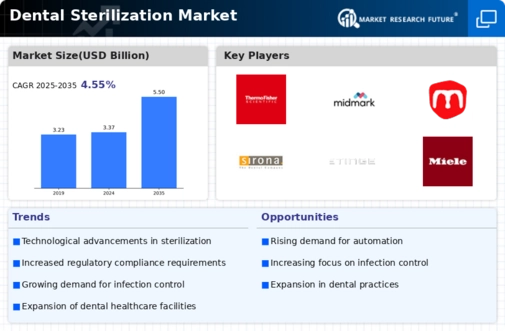Market Trends
Key Emerging Trends in the Dental Sterilization Market
In recent years, notable developments and changes have shaped dental sterilization market indicating changes in health care’s area related to dentistry as well as infection control situation (Dunn & Cox). Among such developments is prioritizing strict adherence to sterilization protocols that ensure safety of both patients and dentists alike. These improvements have led to increased need for complex sanitation devices because it was recognized how vital maintaining sterile environment is especially after awareness about existence or transmission pathogenic infections amongst human population grew enormously..
Market trends in dental sterilizations have been impacted largely by development of new technologies. For laboratories or dentist clinics today integrating modern systems has become an obligation when it comes to teeth cleaning procedures (Dunn & Cox). Autoclaves, chemical sterilants and ultrasonic cleansers are the most commonly used methods of sterilization which have experienced continuous improvement in terms of ease usage, swiftness and efficacy. These modifications not only promote disinfection process but also increase general working performance within dental offices.
The dental sterilization market has been propelled forward by the increasing incidence of dental diseases and volume of dental procedures. The global population is continuously aging and this would lead to significant rise in need for sterilization solutions as demand for oral health services is predicted to escalate. Moreover, increased awareness about oral health care including regular visits to dentists by people has led to rising cases hence requiring more better sterilizations systems in dentist settings.
Standards and compliance are crucial in the oral cleansing sector. Health organizations and governments worldwide have strong standards to safeguard patients and healthcare personnel. This guideline is crucial when buying dental cleaning instruments (Dunn & Cox). Now, manufacturers provide products that satisfy these requirements and are inexpensive and simple to use.
Environmentally friendly dental cleaning practices are another trend. Dental experts are exploring energy-efficient, environmentally friendly techniques to sterilize teeth as consumers grow more environmentally conscious. Companies are producing sterilizers that consume less water, energy, and create less environmental impact because to this trend. This goes together with the overall commitment of healthcare to accountable management of resources and sustainability.
There is currently an increasing trend in collaborations and partnerships among dental institutions, research organizations, and industry players. The main goal for these alliances is boosting research, development and innovation related to dental sterilization technologies. Through exchange of information between practitioners within the field then it becomes possible for them to continue leading in infection control.












Leave a Comment